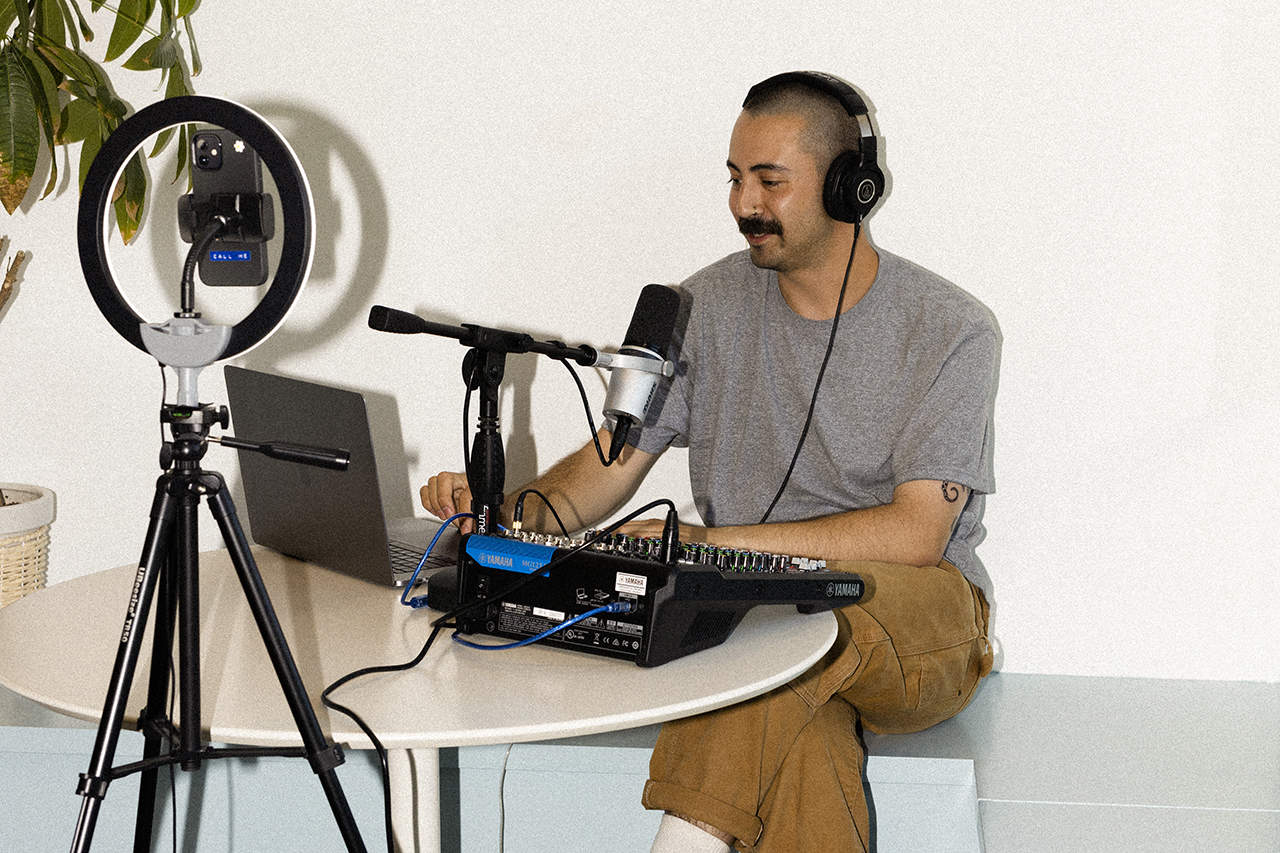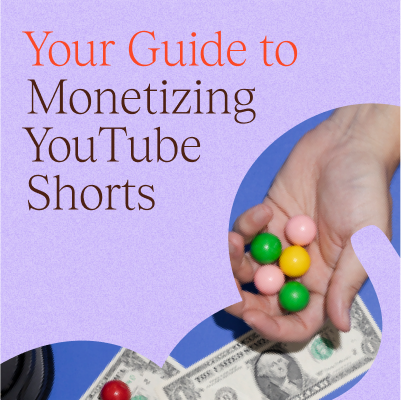When it comes to making money from your YouTube channel, the sky is the limit. But before you embark on your YouTube journey, you’ll want to make sure that you set realistic expectations.
With the right knowledge and the right steps, you’ll be on your way to raking in the big bucks in no time. Wondering how many YouTube views you’ll need to start making money, and just how much you can make from the platform? In this article, we’ll give you an idea of the kind of YouTube money per view you can expect from your videos.
Read on to learn more hot tips on how to increase views — and dollars — on your YouTube channel.

How to get paid on YouTube
Whether you’re just getting started on the platform or gearing up to take your YouTube channel to the next level, chances are the topic of content monetization is taking up a lot of space in your mind.
While you can 100% make money from generating views on YouTube, it all depends on the type of views your videos are generating. There are two different types of views to consider: general views and ad views.
Long story short, general views refer to the overall number of times a video has been watched — basically anytime anyone clicks on a video.
Ad views refer to the number of times an advertisement has been displayed, or played to viewers before, during, or after a YouTube video.
Ad views are only displayed on videos that are monetized by content creators who are part of the YouTube Partner Program (YPP).
In this article, we break down how to earn money from YouTube ad views, including how to become a part of the YouTube Partner Program. Read on to learn more!
YouTube monetization metrics
If you’re new to YouTube, you might be feeling overwhelmed by some unfamiliar terms and acronyms. Here’s a quick breakdown of common monetization metrics and terms that will help you better understand monetizing videos on YouTube.
| Metric/Term | Acronym | Formula |
| Clickthrough rate How many people view an ad or listing versus actually click on it | CTR | CTR = (# of Clicks / # of Views/Impressions) x 100 |
| Cost per mille Measures the amount advertisers pay for every 1,000 ad impressions (or views) | CPM | CPM = (Total cost / Total number of impressions) x 1,000 |
| Revenue per mille Estimates revenue earned per every 1,000 video views, factoring in all sources of YouTube revenue ads | RPM | RPM = (Estimated earnings / # of Views/Impressions) x 1,000 |
| Cost per click Cost per person who clicked on the ad | CPC | CPC = Total cost / Total number of clicks |
| Cost per view Cost per time the ad was viewed (Note: this does not mean unique views!) | CPV | CPV = Total cost / Total views |
| Average ad session duration How long users spend viewing your ad | — | Average ad session duration = Total duration of all ad sessions (in seconds) / Number of ad sessions |
How many views do you need to get paid on YouTube?
To start monetizing your YouTube videos, you’ll need to be accepted into the YouTube Partner Program. Once accepted, the revenue generated from your ad views is shared between YouTube and you, the content creator.
Usually, the creator gets 55% and YouTube takes a 45% cut. That means for every dollar you make, you’ll get $0.55, and YouTube will take $0.45.

How to get accepted into the YouTube Partner Program
To be eligible for YPP, you’ll need to do the following:
- Have at least 1,000 subscribers
- Reach 4,000 valid public watch hours in the past 12 months
- Sign and agree to YouTube’s terms and conditions
- Open an AdSense account
- Get reviewed and approved
Keeping all of these requirements in mind, let’s get into the nitty-gritty of what kind of YouTube money per view you can make on your channel.
How much do YouTubers make per view?
While we wish we could calculate the exact amount of money you can make per video view, sadly, YouTube algorithms are a little more complicated than that.
We can tell you that a lot depends on the category your videos and channel fall under, your content niche, and your geographic location (among other factors).
Additionally, since AdSense is an auction-based advertising engine, some of the keywords that advertisers bid on are worth more than others. Essentially, this means that all creators make a different amount per view based on several factors that advertisers keep in mind, like content niche, location, audience demographic, and more.
How much do YouTubers make per 1,000 views?
First things first, you can calculate your potential earning average based on your industry and region by using Google’s AdSense calculator, which can help give you a better sense of what others in your region or niche are doing.
Most sources on the internet agree the average YouTuber in the U.S. earns approximately $0.018 for each view, which amounts to $18 for every 1,000 views.
Keep in mind that the amount per 1,000 views can be much higher or much lower — it really depends on multiple factors such as ad engagement, audience and geographic location demographics, and content categories.

How much do YouTubers make per 10,000 views?
If we consider that the average YouTuber in the U.S. earns $0.018 for each video view, then we can assume creators would make at least $180 for 10K views.
However, this number is only a generalization and can vary based on the factors we listed above.
How much do YouTubers make per 1,000,000 views?
If we use the same average base earnings of $0.018 per view, then the average YouTuber should make at least $18K from 1 million views.
That being said, as you get into seven-figure views, you might want to get some help with your calculations. We suggest estimating your earnings with our YouTube Money Calculator below.
YouTube ad revenue and creator earnings calculator
Want to know how much money you can make through your YouTube channel (or see how you compare to other YouTube stars)? Let our YouTube Money Calculator do the math for you!
All you need to do is fill in your total number of views, videos, and subscribers, and our calculator will take care of the rest. And by the rest, we mean we’ll provide you with your estimated earnings based on ad revenue-sharing, as well as brand deals and digital product sales.
6 Factors influencing your YouTube earnings
1. Your channel niche

First things first, to be a successful YouTuber, you need to find your content niche.
Below are some of the most profitable YouTube niches with their corresponding average CPM (Quick reminder: CPM is the cost an advertiser will pay for every 1,000 impressions, or views, that their ad receives on YouTube):
- How to make money online – $13.52
- Social media marketing – $12.41
- Finance and investing – $12.25
- Educational videos – $9.89
- Photography and filmmaking – $7.31
- Cars – $4.23
- Lifestyle – $3.47
- Fashion and clothing – $3.13
- Entertainment – $2.74
2. Types of ads

YouTube offers several different types of ad options for content creators to maximize their YouTube earnings. They include:
- Skippable video ads: These ads allow viewers to skip an ad after 5 seconds.
- Non-skippable video ads: These ads must be watched before a video can be viewed (ads usually run between 15 and 20 seconds in length, depending on regional standards).
- Bumper ads: These are short, non-skippable ads of up to 6 seconds that must be watched before a video can be viewed. Bumper ads are turned on when skippable or non-skippable ads are turned on.
Each of these ad types can show up before, during, or after a video and will show up the same on every platform (i.e. computer, mobile devices, TV, and game consoles).
Hot tip: To generate even more ad revenue, many YouTube stars include ads that show up during videos (also known as “mid-roll” ads). These ads can only be added to videos that are at least 8 minutes in length. So if you’re wanting to increase your YouTube earnings, a good rule of thumb is to create content that’s 8 minutes in length (or longer) so you can capitalize on those mid-rolls!
3. Video length and type of content

Video length
As discussed above, considering the length of your content is important when strategizing how to increase your YouTube earnings.
Whether you’re considering a specific video length to capitalize on the types of ads that YouTube offers, or maybe you’re still trying to reach YouTube Partner Program eligibility, video length is an important factor in your content strategy.
For example, let’s say you’re trying to meet your 4,000 watch hours within one year of getting started as a YouTuber. Many content creators suggest producing 20 to 60-minute podcasts or live streams. Why? This type of content counts towards your 4,000 watch hours, but it’s less time-consuming than creating several shorter-length videos that require more production and editing hours.
Type of content
There are several types of content on YouTube. Some of the most popular types include:
- Entertainment: Anything that provides entertainment value. That means pranks, challenges, or pretty much anything with a broad appeal that will make your audience laugh.
- Music: Music videos, covers, and original songs attract a large audience on YouTube. Plus, music videos have the added bonus of attracting the type of viewer that listens to a song (in other words, watches your video) over and over again.
- Gaming: Channels dedicated to gameplay videos and walkthroughs attract millions of viewers daily. This is also a great content area for live-streaming options.
- Vlogs/Lifestyle: Lifestyle content surrounding fitness routines, daily routines, and personal stories attract large audiences.
- How-to/Tutorials: It’s no secret that YouTube is the go-to platform for quickly learning new skills and acquiring knowledge. If you’re an expert on anything, how-to videos are a great way to rack up views (and a great opportunity to share links to your digital products like online courses).
These are just some typical examples of types of revenue-generating content on YouTube. Don’t sweat it if you feel like your content niche doesn’t fit into any of these bullets. As long as you’re sticking to your personal brand, you’re headed down the right path.
4. Subscriber count

Once you’ve successfully joined the YouTube Partner Program, technically, your subscriber count doesn’t influence how much money you make on YouTube. For example, you could have 100,000 subscribers and make less than a penny if you’re not generating ad views.
Nevertheless, your subscriber count definitely contributes to your overall YouTube earnings. How? Well, generally a high subscriber count equates to a loyal fan base (meaning you can trust that your fans are going to watch the entirety of your videos). And at the end of the day, the more subscribers you have, the higher the chances you’ll have making money on YouTube. This includes both ad revenue and alternate ways of making money, such as selling merchandise or digital products, brand sponsorships, and more.
5. SEO (Optimizing your videos with keywords, tags, etc.)

Search Engine Optimization (SEO) is a marketing tactic for optimizing your videos and channel to improve their visibility in YouTube search results. The goal here is to increase “organic traffic”, AKA clicks from viewers that occur naturally (as opposed to paid traffic).
To implement SEO for your YouTube channel, you’ll want to keep in mind the following basics:
- Keyword research: Find relevant keywords and phrases that people are likely to use when searching for content that may be similar to your content niche. Hot tip: Finding keywords may seem intimidating but it can be as simple as using YouTube’s search suggestions, checking Google Trends, or using a third-party research tool to find popular keywords.
- Video title and description: If you want to hook your viewers, write a compelling title and enrich it with high-ranking SEO keywords. Use relevant keywords in your video description as well to help drive even more traffic to your channel.
- Tags: By assigning tags, you’re essentially helping YouTube understand the topic and context of your video. Try using both specific and broader range tags to cover the full spectrum of your video topic.
6. Other methods to make money on YouTube

Beyond ad views, there are several other ways to bring in some serious cash on YouTube. Let’s dive in!
Channel membership
Another perk of the YPP, the channel membership feature is designed with your most dedicated fans in mind. Essentially, your loyal fans sign up to become channel members. They would pay a recurring monthly fee in exchange for exclusive perks like badges, emojis, or members-only videos and live streams.
Super Chat, Super Stickers, and Super Thanks
Yet another YPP benefit, the Super features are a way for your fans to show their support, and give them access to special features that make their interactions with you shine.
YouTube Shopping
Selling merch on YouTube has the potential to influence your earnings. YouTube Shopping allows you to tag and pin products that you’ve promoted in your videos. This feature also allows you to track the revenue performance of tagged products in your YouTube Analytics.
Sell digital products
Selling and promoting your digital products on YouTube like ebooks, online courses, and templates can be a lucrative income stream for creators.
Since digital products don’t require a huge time investment, all you have to do is use some airtime in your videos to promote your digital products, drop a shopping link directly in your video description, and watch your earnings multiply!
Tips for increasing views on YouTube
From the outside looking in, producing YouTube content may look as easy as recording and uploading videos. But as any creator will tell you, there’s a lot more to it than that. So, how do you optimize the hours of work you put into your videos to maximize the number of views you receive? We dish out some tips below.
Optimize your videos for search

Three words: search engine optimization. Also known as SEO, this is a well-established practice that improves your channel’s visibility and rankings in search engine results by adding relevant tags and keywords to your video, title, and description. If implemented strategically, SEO helps prospective fans find your YouTube channel, which in turn increases your subscriber count and ad views.
Create eye-catching thumbnails

Thumbnails play a crucial role in attracting both your established and new viewers. The key here is to really understand your audience, and how the context of your video will speak to them. The goal with thumbnails is to catch a viewer’s attention at the search results page, so you can improve clickthrough rates in your search results.
Make your video intro engaging

Your video intro is crucial for capturing your viewer’s attention and setting the tone for the rest of the video. No pressure, though! You got this, especially if you follow the simple steps below:
- Start with a hook: Whether it’s a question, statement, or a surprising fact, you want to capture your viewer’s attention right out of the gate.
- Show your personality: What sets you apart from other YouTubers? Make that clear in the intro of your videos.
- Use visuals and editing techniques: Your fans will take notice of dynamic editing styles like animation, motion graphics, hand-painted font, original soundtracks, etc.
- Keep it concise: You want to keep your intro to about 5 to 10 seconds to quickly engage viewers without losing their interest.
Promote your YouTube videos on social media

Promoting your videos across multiple social media channels can be a lucrative tactic that also allows you to exercise your content creation skills on other platforms.
Think of video teasers and clips, eye-catching thumbnails, and live streaming. These different mediums help drive traffic to your YouTube channel, while also building engagement on other social media platforms like Instagram and TikTok.
Time to make that YouTube money!
You can deliberate until the cows come home about how much YouTube money per view of a video you can make, or, you can get started today!
Your first step is to meet the eligibility requirements of the YouTube Partner Program. From there, you can increase your YouTube AdSense revenue by monetizing both your long videos and YouTube Shorts.
Want more tips on how to make money on YouTube? Get our free YouTube Shorts Monetization Guide for inspiration on how to maximize your earnings.
FAQ
How much does YouTube pay for 1,000 views?
There are several factors that could affect your CPM (cost per mille). For example, how many people watch the advertisements on your videos, your region, and your content niche. On average, a YouTuber in the U.S. earns around $0.018 for each view, which amounts to $18 for every 1,000 views.
How much does YouTube pay you for 1 million views?
Chances are, if you have a video that has a million views, you’re on the path to becoming a full-time YouTuber. But how much can you really make from 1 million views?
Most YouTube stars will agree that the general estimate for 1 million YouTube views ranges between $1,200 to $6,000. And that’s just from what YouTube pays for YouTube ads. If you think about one million views per video, plus all of the alternate ways you can make money through YouTube (like brand sponsorships, or selling merch or digital products), then you’re cooking!
Can I monetize my YouTube channel without 1,000 subscribers?
Yes! If you haven’t reached 1,000 subscribers, you’re in luck! As of June 2023, YouTube has expanded its YouTube Partner Program to allow early access to certain features for creators who have yet to reach 1,000 subscribers.
To be eligible for the expanded YPP, you’ll need to meet these minimum requirements:
- Have at least 500 subscribers
- Have 3 valid public uploads in the last 90 days
- Reach 3,000 valid public watch hours in the last 12 months, or 3 million valid public Short views in the last 90 days
If you’ve yet to reach 500 subscribers, don’t worry, there are still plenty of other ways to make money through YouTube. Affiliate marketing or selling digital products are all terrific income streams for creators.
Follow The Leap on TikTok, Instagram, and YouTube for more monetization tips for creators. We also make a newsletter.
Further reading
- YouTube Money Calculator: Estimate How Much You Can Make on YouTube
- YouTube Monetization Requirements: How to Monetize Your Videos in 2024
- YouTube Shorts Monetization: How To Start Earning (Even Without 1,000 Subscribers)
- 11 Tips for Getting Your First 1000 YouTube Subscribers
- How Much Do YouTubers Make?




